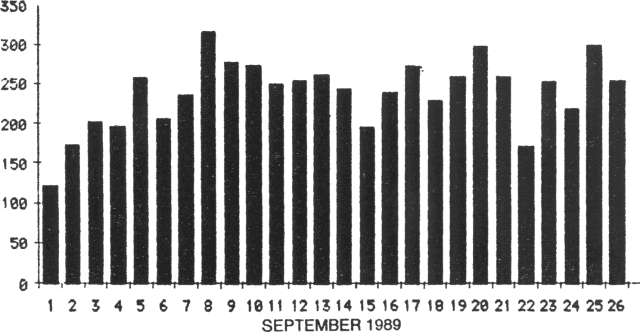Report on Poas (Costa Rica) — September 1989
Scientific Event Alert Network Bulletin, vol. 14, no. 9 (September 1989)
Managing Editor: Lindsay McClelland.
Poas (Costa Rica) Continued thermal activity; seismicity increases slightly
Please cite this report as:
Global Volcanism Program, 1989. Report on Poas (Costa Rica) (McClelland, L., ed.). Scientific Event Alert Network Bulletin, 14:9. Smithsonian Institution. https://doi.org/10.5479/si.GVP.SEAN198909-345040
Poas
Costa Rica
10.2°N, 84.233°W; summit elev. 2697 m
All times are local (unless otherwise noted)
Gas emission from the hot crater lake continued without major changes. The lake's level rose about 1.5 m after heavy rains. Fields of sulfur cones (with castle-like forms), mud springs, and fumaroles were still present on the N and SE sides of the lake. Sulfur deposition formed a yellow scum on the lake.
Volcanic microseismicity recorded by Red Sismológica station VPS-2 increased to a daily mean of 241 for the first 26 days of September (figure 22). Geologists attributed the seismicity to conversion of water from the aquifer below the volcano to vapor bubbles.
 |
Figure 22. Number of seismic events/day recorded by Red Sismológica station VPS-2, 1-26 September 1989. Courtesy of Mario Fernández A. |
Geological Summary. The broad vegetated edifice of Poás, one of the most active volcanoes of Costa Rica, contains three craters along a N-S line. The frequently visited multi-hued summit crater lakes of the basaltic-to-dacitic volcano are easily accessible by vehicle from the nearby capital city of San José. A N-S-trending fissure cutting the complex stratovolcano extends to the lower N flank, where it has produced the Congo stratovolcano and several lake-filled maars. The southernmost of the two summit crater lakes, Botos, last erupted about 7,500 years ago. The more prominent geothermally heated northern lake, Laguna Caliente, is one of the world's most acidic natural lakes, with a pH of near zero. It has been the site of frequent phreatic and phreatomagmatic eruptions since an eruption was reported in 1828. Eruptions often include geyser-like ejections of crater-lake water.
Information Contacts: G. Soto, Mario Fernández, and Héctor Flores, Univ de Costa Rica.

